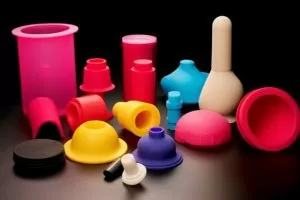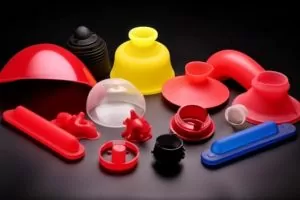Nowadays, silicone rubber and ordinary rubber are used in various fields in our daily lives. From rubber handles to kitchen utensils to medical and aircraft components, silicone rubber and regular rubber can be found everywhere. When designing products, especially applications reinforced with rubber components, choosing the right rubber type between silicone and rubber is crucial. By understanding the subtle differences between two materials, someone can make a more satisfying product than someone who doesn’t pay attention to the intricacies.
When selecting materials for use in the manufacture of various products and goods, it is necessary to recognize the advantages and disadvantages of the many rubber types currently available in the consumer market. Many rubber products have proven to be versatile. Silicone rubbers and regular rubbers are the two most talked about types of rubber used in different industries. These materials have very different properties, applications, and even their manufacturing processes are significantly different.

With this blog post, we not only educate manufacturers, consumers, and industry experts about the diversity of rubber processing types; we also provide them with an insight into the diversity of rubber processing types.
Basic Knowledge of Silicone and Ordinary Rubber
What is Silicone Rubber?
Silicone rubber is a hydrocarbon polymer with silicon, carbon, hydrogen, and oxygen as its main components. It is an artificial synthetic materials. It is popular for its excellent properties such as good heat resistance, excellent flexibility and biocompatibility. This makes it a leading choice for applications that are subject to large temperature changes or other adverse conditions.

Silicone rubber is commonly used in applications where extreme temperatures and environmental hazards are a concern, such as gaskets and sealants in the automotive sector. Its versatility is described by the opportunity it offers to create different grades, including conductive, flame retardant and medical grade silicones.
What is Ordinary Rubber?
Often called rubber or natural rubber, it is extracted from latex, a natural product of the rubber tree, which is a natural compound produced by the rubber tree. The main chemical components are separated, leaving cis-1,4-polyisoprene and some impurities in the form of proteins, water and inorganic compounds. Its properties are high elastic material, good tensile strength, considerable resistance to wear and tear, and abrasion resistance to solvents and moisture.

Regular rubber is an inexpensive option for many common everyday uses, such as tires or shoes. It can be found everywhere and in many objects. While regular rubber is not as strong as silicone in terms of chemical resistance, this material does have a lot in common with it in terms of flexibility and tensile strength.
The Origin of Silicone Rubber
Silicone elastomers, a compound that has emerged in recent times, have become a very rare material with excellent thermal, chemical and electrical resistance as well as flexibility properties (mainly under extreme conditions). Regular rubber, while a typical material for many applications, does not inherently possess all the standby qualities that silicone rubber offers.

1. What Makes Silicone Different
Silicone rubber is unique in that it can withstand temperatures from -55 to 300 degrees Celsius without showing any signs of mechanical or physical quality changes that are typically thought to occur in extreme heat or cold applications. This makes it ideal for such applications. First, silicones do not melt, burn, or melt like any ordinary rubber; they are thermally stable, chemically inert, and do not react to extreme forces. Therefore, silicones perform well in conditions where most rubber would break down in due course.

2. Explore Chemistry
As for chemical resistance, this is where it gets fuzzy. Unaffected rubber (here again used under normal conditions) can dissolve different compounds. However, rubber-based silicone gives this material uncompromising resistance not only to the most aggressive or corrosive agents, but also to chemical attack. This property makes it an effective choice for a wide range of chemicals, except where other rubbers would fail completely.

Understand the Basic Differences
Chemical Composition
Silicone rubber is made from silica, an element found underground that is second only in weight to oxygen. This component chemically determines the polymer’s properties, especially its excellent heat resistance.
Although natural rubber is known for its less complex chemical composition compared to synthetic rubber, which in turn is based on hydrocarbons. This is why regular rubber is more affected when exposed to strong environmental influences compared to silicone rubber.

Mechanical Behavior
Silicone rubber exhibits high wear resistance and elongation, which allows it to withstand different mechanical loads caused by compression, deformation and shear without cracking or changing the initial shape. In contrast, rubber typically has excellent resilience and wear resistance, which means they are suitable for surfaces that are often in contact with hard and rigid objects and subject to impact.

Thermal Resistance
Silicone rubber can score top marks in extreme temperature tests because it maintains its properties at temperatures as high as 500°F (260°C) and as low as -100°F (-70°C) its performance. The rubber we commonly use is usually organic in nature and, therefore, its use is limited to a high temperatures range of approximately 140°F (60°C).

Applications and Industries
Silicon for the Electronics and Medical Industries
The bioinertness of silicones is considered a major advantage, making the industry important in the medical field where devices such as prosthetics and implants are provided. In addition to its electrical properties, it effectively encloses and insulates electronic components, especially at heated temperatures.

Common Rubber in Tires and Auto Parts
The great toughness of rubber extends to its mechanical properties, making it a standard in the automotive industry, incorporating the production of tires, gaskets and various mechanical components. The shock-absorbing and shock-resistant properties of (EVA) are not only used in sports equipment and footwear, but also extend to the structure of footwear, where soft landing and cushioning of the foot are important requirements.

Manufacturing Differences
Vulcanization Process
The manufacture of regular rubber requires vulcanization, a chemical process used to convert natural rubber or related polymers into a more durable material. This method usually involves the use of sulfur and other curing agents during the heating of the rubber. In fact, silicone rubber does not need to be vulcanized like polymers because it starts forming a network from the start.
Molding and Processability
Due to its greater thermal stability, silicone rubber is the preferred choice in many industries because it can be formed into highly complex shapes using many different processes, including compression molding, transfer molding, and liquid silicone rubber (LSR) injection molding. An alternative to regular rubber is to use silicone, which is highly malleable but requires more precise control of temperature and machine pressure during production.

Environmental Impact and Sustainability
Biodegradability and Disposal
Rubber is the most common substance. Although it is natural rubber, it will decompose if left for a long time. Because the process can be slow and involve specific conditions, the results will also be slow. An environmental disadvantage of silicone rubber may also be that it does not break down easily.
In fact, over the past few decades, silicone waste has become less troublesome due to the continuous development of new technologies and recycling. Innovative and recycling technologies are gradually mitigating the silicone waste problem.

Renewable Resources
Natural rubber can be extracted from rubber trees grown on ecologically conscious rubber plantations. Additionally, more and more manufacturers and consumers prefer rubber sourced from responsible and eco-friendly practices, so the production process is environmentally friendly. However, silicone rubber is primarily made from silanes obtained from silicates found in ground sand, a byproduct of burning biomass sources.
Cost Considerations
Production Costs
The reason why silicone rubber is more expensive to produce may be due to the nature of its raw materials and what appears to be more complex manufacturing techniques. In addition, the molding process of soft silicone rubber often requires expensive special molds, which also increases the price of the initial product.

Long-term Durability
Since silicone rubber has higher start-up costs compared to other materials, the durability of silicone rubber is often worth the cost. Silicone production often exceeds its yield in applications where heat resistance and aging properties are favorable. Silicone products last longer and save a lot of time.
Case Study: Silicone Seals vs. Regular Rubber Seals
Silicone sealing rings and ordinary rubber sealing rings are common sealing materials, but there are certain differences in performance and use.

Material
Ordinary rubber sealing rings are made of natural rubber or synthetic rubber, while silicone sealing rings are made of silicone rubber. Rubber is natural rubber, derived from the latex produced by rubber trees, while silicone rubber is made from polymer chains, which are long-chain molecules derived from refined petroleum and coal. It can be seen that silicone rubber is superior to ordinary rubber in terms of high temperature and corrosion resistance, so it has more practical significance for various special applications.
Temperature Resistance
Silicone seals exhibit better operating capabilities than standard rubber seals in the temperature range of -60°C-230°С. Therefore, they can operate smoothly within the specified temperature range. This high temperature performance gives the material many advantages and is widely used in applications that require high temperature resistance, such as automotive air conditioning hoses, gasoline seals and compressed air systems, aircraft jet engines, photovoltaic devices and other fields. Standard rubber-type seals have a limited operating temperature range compared to the ambient temperature range, typically -40°C -120°C.

Chemical Resistance
Sealing materials made from silicone are more resistant to chemical agents than their regular rubber counterparts. Small silicone seals, such as O-rings, gaskets, etc., are widely used in harsh environments.
For example, acids, alkalis and organic solvents will corrode ordinary rubber seals, but silicone seals can withstand these media and function. Therefore, due to the particularities of certain industrial fields, such as the pharmaceutical, chemical and oil exploration industries, it is necessary to choose silicone sealing rings.

Sealing Performance
Compared with rubber sealing rings, silicone material sealing rings improve sealing efficiency. Gas and fluid seals made of silicone are effective in preventing leaks because the rubber is less likely to become brittle and hard, and the seals have a relatively long service life.
Among the benefits of using silicone seals, this is a major factor that has made silicone seals popular in industrial sectors such as automotive manufacturing, aerospace systems, electronics, and other industries that require silicone seals in large quantities.

Cost
A common reason why silicone seals cost more than regular rubber rings is the quality of the material. This is because the cost of silicone raw materials is high and the production process is complex.
However, in special occasions, the high temperature resistance, chemical resistance and excellent sealing performance brought by silicone seals exceed their cost and are more acceptable than traditional rubber seals.
All in all, these two sealing methods (silicone seals and ordinary rubber seals) have the same basic principles, but each has its own advantages and disadvantages.
In the practice of sealing materials in real life, appropriate sealing materials are selected based on project needs and actual conditions.

When to Choose Silicone Rubber?
Unlike natural rubber, silicone rubber can be a versatile choice in certain applications because:
1. Extreme Environment
With this, we can greatly define the range within which silicone can operate, which is very helpful, especially in large kitchens and industrial kitchens that sometimes have extreme temperatures. Consider the case of aerospace applications, where parts need to operate at temperatures above acceptable limits, and where medical devices need to be cumulatively exposed to various sterilization procedures.

2. Medical and Food Grade Applications
Biocompatibility and its use in prosthetics, catheters, and medical tubing make medical-grade silicone a must-have material. Instead, food-grade silicone should be prioritized for baking utensils and kitchenware because it won’t soak into food, is dishwasher safe, and is non-stick.
3. Electrical and Electronic Equipment
In addition to silicone’s ability to withstand high voltages and its insulating properties, electrical utilities, as well as silicone and electronics manufacturers, have found it indispensable in cables, connectors and other electronic components.
It is known for its eco-friendly nature and is therefore very popular in the semiconductor industry.

When to Choose Ordinary Rubber
1. Everyday Items and General Settings
The reason is that simple, everyday things like transporting loads or simple consumer goods rarely require anything other than plain rubber. Its greater stretch elasticity is thought to be related to its low cost, making it compatible with sportswear such as balls, shoes and rubber bands.
2. Industrial Applications
For example, in less demanding industrial environments where chemical exposure and temperature fluctuations are not major considerations, a rubber with a lower strength preference may be satisfactorily suitable for its use. It is often chosen when working with conveyor belts, seals and gaskets, and simple parts.

3. Sustainability and Biodegradability
What many people may not consider is that the eco-benefit of rubber is that it degrades when buried – a key factor in the environmentally friendly production and environmental awareness of the product. This feature is useful for items that are ultimately discarded due to the ability to easily recycle into these categories such as packaging.
The Future of Rubber Products
Due to the continuous development and advancement of materials science, silicone rubber is likely to become synonymous with ordinary rubber, and the difference between silicone rubber and ordinary rubber may become blurred.
Now, hybrid materials, such as fluoroelastomer synthetic elastomers materials, are improving performance in many of these demanding applications. Over time, however, the differences between these rubber types should become crucial to vaping developers and their users.

Research into next-generation green rubber products is believed to correct the tire industry’s image. As we slowly move towards a decidedly green culture, compostable rubber has become a recent trend with the added side of improving the environment.
Conclusion
The market for rubber products is huge, and silicone and ordinary rubber varieties only account for a small part of all rubber products. However, although the number of its subgenres may be infinite, we are talking about those subgenres among them that have their own characteristics and a special place in books on material science. Each type has its own set of properties, uses, and unique place in the grand tapestry of materials science.
However, understanding these contrasts between materials is not just for academics, but is also a useful tool that engineers, designers, and anyone else building products must understand in order to choose the right materials for the product. An integral part of understanding both materials comes from understanding the nuances of rubber and silicone. In turn, these will enable more informed decisions to be made, making the application of both materials safer, more efficient and more practical.

The silicone versus rubber controversy is not a black and white matter but a complex balancing act which recognizes the application situations in a composite manner and selects technology accordingly. On the way of heading to more stable, utility-based materials, we must acknowledge the good and the bad sides of each component.
From the everyday comfort of feel reliable to the groundbreaking performance of the silicone rubber, the repeating materials that go into manufacturing a huge range of products we use on a regular basis deserve to be known and appreciated by us all on a much deeper level.



